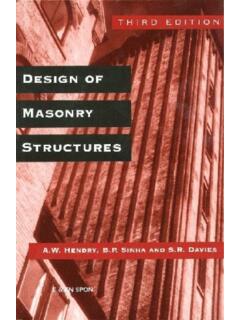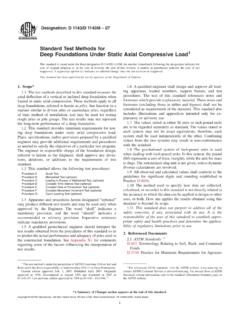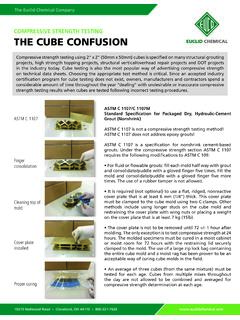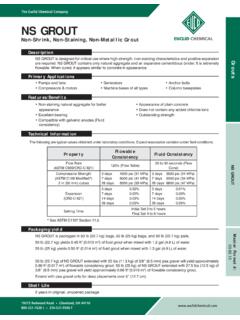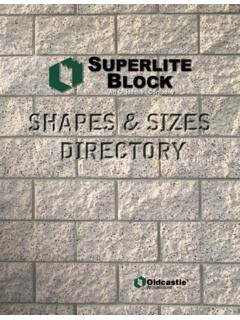Transcription of ASTM C90, Standard Specification for Load-Bearing Concrete ...
1 Standards for Concrete Masonry UnitsASTM C90, Standard Specification for Load-Bearing ConcreteMasonry and solid loadbearing Concrete blocks are coveredin this Standard . Weight classifications are divided into Light Weight (lessthan 105 lb/cu ft oven dry weight of Concrete ), Medium Weight (105 to lessthan 125 lb/cu ft), and Normal Weight (125 lb/cu ft or more). Unit weightaffects water absorption, sound absorption, sound transmission, and thermaland fire resistance. There are no default requirements in ASTM C90, so thespecifier must designate unit type and weight classification if these proper-ties are important to the minimum net areacompressive strength required for all threeweight classifications for ASTM C90 loadbearing units is 1900 strength is largely a function of the characteristics of the aggre-gate used in the units, and may vary regionally according to the types ofaggregates available.
2 Aggregates in some areas may routinely produce unitswith much higher compressive strengths without a cost premium. If a specif-ic unit strength requirement greater than the Standard minimum isrequired, that compressive strength should be required by the project with the requirements of ASTM C90 is verified by testing inaccordance with ASTM C140, Standard Method of Sampling and TestingConcrete Masonry is referenced in the C90 Standard and need notbe listed separately in the project Specification . ASTM C90 also referencesASTM C33, Standard Specification for Aggregates for Concrete ,and ASTMC331,Lightweight Aggregates for Concrete Masonry Units,as well as stan-dards for the cementitious materials that are permitted in these units. It is notnecessary for the specifier to list these referenced standards tolerances and limits on chippage and cracking are covered in thetext of the Standard .
3 These requirements are more liberal than those for claybrick because of the nature of the material and the method of exposed architectural units such as split-face, ribbed, or ground-faceunits, these requirements may not be appropriate. Rough units may requiregreater tolerances and ground face units tighter tolerances. For such prod-ucts, it may be more appropriate to consult local manufacturers for tolerancerequirements. Color is not covered in this Standard , so the specifier mustdesignate the desired color by specifying a proprietary product, with colorand color range verified with a sample panel or mock-up C129, Standard Specification for Non- Load-Bearing ConcreteMasonry requirements of this Standard are similar to those ofC90 except that the units are designed for non-loadbearing applications. Unitweight classifications are the same, as well as referenced standards for aggre-gates, cements, sampling, and testing.
4 Since the units are designated as non-loadbearing, the minimum requirements for net area compressive strength arelower than for ASTM C90 units at an average of only 600 psi. For typical non-loadbearing applications, this strength is more than adequate, but strongerunits may be commonly available without a cost premium in some areas. Colorrequirements are not covered in the Specification , and should be specified inthe same way as that recommended for ASTM C90 C55, Standard Specification for Concrete Building brick can be loadbearing or non-loadbearing. Grading is based onstrength and resistance to weathering. Grade N provides high strength Industry Standards for Masonry557 Downloaded from Digital Engineering Library @ McGraw-Hill ( )Copyright 2004 The McGraw-Hill Companies. All rights use is subject to the Terms of Use as given at the ASSURANCE AND QUALITY CONTROL resistance to moisture penetration and severe frost action.
5 Grade S has only moderate strength and resistance to frost action and moisture gross area compressive strength for Grade N units is 3500 psi andfor Grade S units, 2500 psi. ASTM C55 does not include requirements forcolor, texture, weight classification, or other special features. These proper-ties must be covered separately in the project specifications. Sampling andtesting are referenced to ASTM C140, and standards for aggregates andcements are also referenced, so the specifier need not list these Standards for Masonry Mortar and GroutASTM C270, Standard Specification for Mortar for Unit Standard covers four types of masonry mortar made from a variety ofcementitious materials, including portland cement (ASTM C150), mortarcement (ASTM C1329), and masonry cement (ASTM C91), as well as blendedhydraulic cement and slag cement (ASTM C595), quicklime (ASTM C5), andhydrated masonry lime (ASTM C207).
6 These material standards are refer-enced in ASTM C270, so the specifier need not list them separately. If anymaterials are to be excluded for any reason, this should be noted in the pro-ject specifications. Requirements for mortar aggregates are referenced toASTM M, S, N, and O mortar may be specified to meet either the pro-portion requirements or the property requirements of ASTM C270. If the pro-ject specifications do not designate which method the contractor must use,then the proportion method governs by default. The proportion method is themost conservative, and will usually produce mortars with higher compressivestrengths than those required by the property method. It is generally notdesirable to use mortar that is stronger in compression than the applicationrequires. To optimize mix design, property-specified mortar requires precon-struction laboratory testing in accordance with the test methods included inASTM C270.
7 These test methods are not suitable for testing of field-sampledmortar during construction, and cannot be compared to the results of suchtests. If field testing of mortar will be required, then bothpreconstructionand construction phase testing should be performed in accordance withASTM C780 rather than ASTM C270. There is no test method for accuratelymeasuring the compressive strength of hardened mortar removed from acompleted masonry wall or for appropriate use of the four basic mortar types areincluded in a non-mandatory Appendix X1 to ASTM C270 and are summa-rized in Chapter C476, Standard Specification for grout for covers two types of masonry grout fine and coarse. The same stan-dards for cementitious materials are referenced as those in ASTM C270, butaggregates must conform to ASTM C404. Fine grout is used for small groutspaces and coarse grout for economy in larger grout spaces (see Chapter 6).
8 Masonry grout may be specified to meet the proportion requirements includ-ed in the Standard , or it may be required to have a minimum compressivestrength of 2000 psi when sampled and tested in accordance with ASTM1019. If higher compressive strength is required for structural masonry, therequired strength should be indicated in the contract C476 permits the use of pumping aid admixtures in caseswhere the brand, quality, and quantity are approved in writing. Such admix-558 Chapter 17 Quality Assurance and Quality ControlDownloaded from Digital Engineering Library @ McGraw-Hill ( )Copyright 2004 The McGraw-Hill Companies. All rights use is subject to the Terms of Use as given at the ASSURANCE AND QUALITY CONTROL

